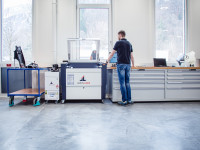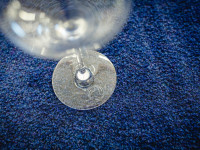From acrylic to steel
The universal use of laser cutters
Laser cutters have experienced an enormous boom in recent years and have become indispensable in various industries. From art to industry, they offer precise and fast cuts for a variety of materials.
How a laser cutter works
A laser cutter uses a focused beam of light to cut or engrave materials. The laser beam is directed through an optical system and focuses on a small spot that generates immense heat. This heat is strong enough to melt, burn or vaporize materials, resulting in precise cuts and engravings. There are two main types of laser cutters: CO2 lasers, which are often used for non-metallic materials, and fiber lasers, which are preferred for metal processing.
Materials that can be processed with laser cutters
Acrylic
Acrylic is one of the most common materials processed with laser cutters. It is easy to cut and engrave and is often used for advertising signs, displays, jewelry and decorative items. Acrylic offers the advantages of a smooth cut edge and the possibility of being available in different colors and thicknesses.
Wood
Laser cutters are ideal for processing wood. They are used in furniture manufacturing, model making and in the creation of works of art. Lasers can engrave detailed patterns and designs into wood that would be difficult or impossible to achieve using traditional methods.
Leather
Leather can be precisely cut with a laser cutter to make shoes, bags and other accessories. The added ability to engrave fine details and patterns in leather makes the laser cutter an indispensable tool for designers and craftsmen.
Textiles
Textiles such as cotton, polyester and silk can also be processed with laser cutters. This enables the creation of tailor-made garments, curtains and other textile products with precise cuts and complex designs.
Metals
Metals such as steel, aluminum and brass are often cut with fiber lasers. This type of laser cutter is used in the automotive industry, mechanical engineering and architecture. The ability to cut thick metal plates precisely makes the laser cutter an important tool in industrial production.
Applications in various industries
The versatility of laser cutters can be seen in numerous industries:
- Advertising technology: creation of advertising signs, logos and displays made of acrylic or plastic.
- Furniture and interior design: filigree woodworking, customized designs and engravings on surfaces.
- Electronics industry: Precise cuts for foils and housings or the labeling of circuits.
- Automotive industry: Precise markings on metals for components, safety elements and prototypes.
- Jewelry production: engraving on precious metals such as gold or silver.
Technological advantages of using laser cutters
Precision and accuracy
One of the biggest advantages of laser cutters is their precision. They can cut and engrave extremely fine details and complex patterns with high accuracy. This is particularly important in industries such as electronics and medical technology, where precision is crucial.
Speed and efficiency
Laser cutters are fast and efficient. They can cut large quantities of materials in a short time, which shortens production time and increases efficiency. This is particularly advantageous for mass production.
Versatility
The versatility of laser cutters is another major advantage. They can cut and engrave a variety of materials, making them a versatile tool for different industries. Whether wood, metal, leather or textiles - a laser cutter can process them all.
Minimal material loss
As laser cutters are very precise, there is minimal material loss. This is particularly important with expensive materials such as metal or acrylic. The laser cutter cuts the material exactly where it is needed, reducing waste.
The universal use of laser cutters makes them an indispensable tool for modern production processes. Their versatility enables the processing of a wide range of materials - from soft textiles to robust steel - and therefore offers tailor-made solutions for complex and intricate designs in numerous industries.



